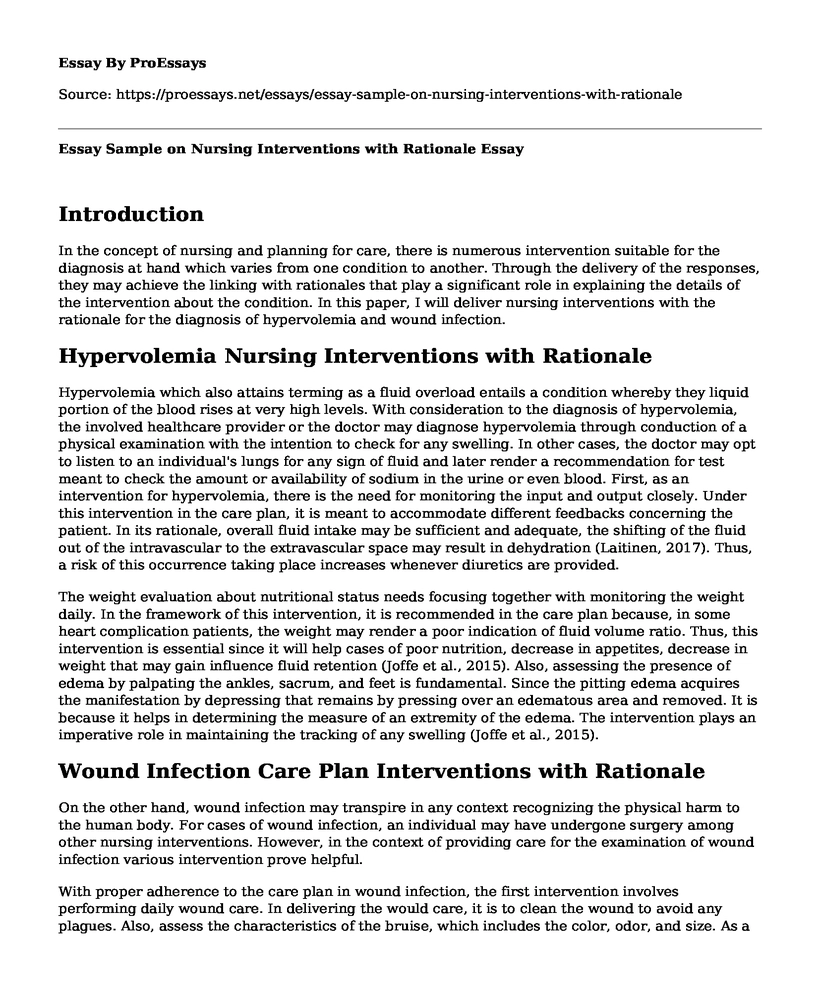Introduction
In the concept of nursing and planning for care, there is numerous intervention suitable for the diagnosis at hand which varies from one condition to another. Through the delivery of the responses, they may achieve the linking with rationales that play a significant role in explaining the details of the intervention about the condition. In this paper, I will deliver nursing interventions with the rationale for the diagnosis of hypervolemia and wound infection.
Hypervolemia Nursing Interventions with Rationale
Hypervolemia which also attains terming as a fluid overload entails a condition whereby they liquid portion of the blood rises at very high levels. With consideration to the diagnosis of hypervolemia, the involved healthcare provider or the doctor may diagnose hypervolemia through conduction of a physical examination with the intention to check for any swelling. In other cases, the doctor may opt to listen to an individual's lungs for any sign of fluid and later render a recommendation for test meant to check the amount or availability of sodium in the urine or even blood. First, as an intervention for hypervolemia, there is the need for monitoring the input and output closely. Under this intervention in the care plan, it is meant to accommodate different feedbacks concerning the patient. In its rationale, overall fluid intake may be sufficient and adequate, the shifting of the fluid out of the intravascular to the extravascular space may result in dehydration (Laitinen, 2017). Thus, a risk of this occurrence taking place increases whenever diuretics are provided.
The weight evaluation about nutritional status needs focusing together with monitoring the weight daily. In the framework of this intervention, it is recommended in the care plan because, in some heart complication patients, the weight may render a poor indication of fluid volume ratio. Thus, this intervention is essential since it will help cases of poor nutrition, decrease in appetites, decrease in weight that may gain influence fluid retention (Joffe et al., 2015). Also, assessing the presence of edema by palpating the ankles, sacrum, and feet is fundamental. Since the pitting edema acquires the manifestation by depressing that remains by pressing over an edematous area and removed. It is because it helps in determining the measure of an extremity of the edema. The intervention plays an imperative role in maintaining the tracking of any swelling (Joffe et al., 2015).
Wound Infection Care Plan Interventions with Rationale
On the other hand, wound infection may transpire in any context recognizing the physical harm to the human body. For cases of wound infection, an individual may have undergone surgery among other nursing interventions. However, in the context of providing care for the examination of wound infection various intervention prove helpful.
With proper adherence to the care plan in wound infection, the first intervention involves performing daily wound care. In delivering the would care, it is to clean the wound to avoid any plagues. Also, assess the characteristics of the bruise, which includes the color, odor, and size. As a rationale, it is to find any traces of infection. For example, pale tissue color signifies low oxygenations and smell may be as a result of diseases especially the necrotic tissue (Bryant & Nix, 2015). The assessment of the body temperature is essential. The intervention is to help determine any other effects or infection. Fever may indicate inflammation and infection. In conclusion, encourage a healthy diet and give medication. It is to improve the condition and wound healing together with proper diet observation (Hughes, 2016).
Conclusion
To sum everything up, a nursing care plan is a practice that is a requisite check in the context of providing quality patient care primarily for the diagnosis of wound infection and hypervolemia. Their significance is evident through the definition of nursing roles in the treatment of a patient and care that allow the involved healthcare provider deliver proper intervention together with their rationales.
References
Bryant, R., & Nix, D. (2015). Acute and Chronic Wounds-E-Book. Elsevier Health Sciences.
Hughes, M. A. (2016). Wound infection: a knowledge deficit that needs addressing. British Journal of Nursing, 25(6), S46-S51.
Laitinen, J. (2017). Evaluation of Intravenous Fluids in Acute Renal Colic.
Joffe, A. M., Khandelwal, N., Hallman, M. R., & Treggiari, M. M. (2015). Assessment of circulating blood volume with fluid administration targeting euvolemia or hypervolemia. Neurocritical care, 22(1), 82-88.
Cite this page
Essay Sample on Nursing Interventions with Rationale. (2022, Apr 16). Retrieved from https://proessays.net/essays/essay-sample-on-nursing-interventions-with-rationale
If you are the original author of this essay and no longer wish to have it published on the ProEssays website, please click below to request its removal:
- Research Paper on Gestational Diabetes Mellitus
- Paper Example on Health Risk Behavior
- Diabetes Mellitus Type 1 Research Paper Example
- Literary Analysis Essay on Notes From Underground by Fyodor Dostoyevsky
- Essay: Why Smoking Should be Banned
- Essay Sample on School-Based Programs: Reducing Tooth Decay in Kids
- Paper Sample on Infant-Mother Attachment: Exploring the Secure Base







